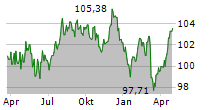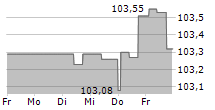(Oslo, Norway, 22 July 2025) - Statkraft delivered strong operational performance in the second quarter of 2025, despite lower prices, especially in the northern price areas of Norway and Sweden. Net results were negatively impacted by impairments, mostly due to lower estimated future power prices in certain regions, and currency effects. Statkraft continues to refocus for profitable growth.
- Power generation in the second quarter 2025 was 15.2 TWh (14.4), and generation was record-high at 36.9 TWh in the first half of 2025 (33.7).
- Power prices were 26.5 EUR/MWh in the Nordic region in the quarter, down 8.8 EUR/MWh from the second quarter 2024. The average base price in Germany fell by 2.1 EUR/MWh from the second quarter of 2024 to 69.8 EUR/MWh in the quarter.
- Net operating revenues were NOK 9.3 billion in the second quarter 2025 compared to NOK 11.2 billion in the second quarter last year. Underlying EBITDA was NOK 4.5 billion (NOK 6.5 billion).
- Statkraft had impairments of NOK 6.3 billion in the second quarter, mainly caused by lower estimated future power prices, particularly in the northern part of the Nordics, following Statkraft's annual update of the long-term price forecast. This included NOK 2.5 billion in impairments related to Swedish wind power assets and NOK 0.5 billion related to Norwegian wind power assets.
- Net financial items were NOK -2.4 billion (NOK 1.6 billion), including net currency losses of NOK 2.1 billion, while profit before tax was NOK -5.1 billion (NOK 1.0 billion) and net profit was NOK -6.5 billion (NOK -1.0 billion).
- Statkraft announced further plans for investments in Norwegian hydropower, including license applications for large capacity upgrades of the Nore and Aura hydropower plants.
- Final investment decisions were made for two hybrid solar projects (203 MW) in connection to the Jerusalém and Boqueirão wind complex in Brazil, and the 97 MW Necton rotating stabiliser project in the UK.
- Statkraft's largest solar farm to date, the 450 MW Khidrat solar farm in India reached commercial operation.
- Statkraft signed a number of power purchase and sales agreements, including its first two long-term power purchase contracts of renewable electricity in the US.
- Statkraft signed an agreement to sell the Enerfin assets in Colombia in the quarter. In July Statkraft sold the development activities in Croatia.
- Statkraft further sharpened its strategy and announced an aim to decrease complexity and reduce costs with around NOK 2.9 billion annually by 2027, compared to the estimate for 2025.
"Statkraft had high power generation and record-high realised price-margin contributing to strong operational performance in the quarter. Power prices were lower in the Nordics - especially in the northern price areas of Norway and Sweden. Lower estimated future power prices in this region contributed to impairments of NOK 3.0 billion related to our Swedish and Norwegian onshore wind portfolio," says Statkraft President and CEO, Birgitte Ringstad Vartdal.
Refocused strategy
After a period of high energy prices following the Russian war on Ukraine, prices are now down. The cost per MW has increased across several technologies, financing costs are higher, and global uncertainty has reached extraordinary levels. All these developments are impacting our investment capacity and cost base, as well as negatively affecting investor confidence, leading to delays in some investment decisions and in Statkraft's planned divestments.
After Birgitte Ringstad Vartdal took over as CEO in April 2024, Statkraft announced to streamline the portfolio and operations - focusing on fewer technologies and markets - and freeing up investment capacity to build scale in core activities and markets.
To reduce the international footprint, Statkraft has successfully closed the sales of its development activities in Croatia and Enerfin assets in the US. An agreement to sell Enerfin assets in Colombia has also been signed. Sales processes for solar- and hydropower assets in India, solar assets and development activities in the Netherlands, and Enerfin assets in Canada continue, along with an assessment of the investment position in solar, wind and batteries in Poland. The development activities in Portugal and Australia have been stopped.
To reduce the number of technologies, Statkraft is seeking new owners for the district heating operations, as well as working on bringing new owners into the biofuels company Silva Green Fuel and the EV charging company Mer. These processes are still ongoing.
In the annual strategic review in June, Statkraft decided on a new, refocused strategy to strengthen core activities, optimise the portfolio and reduce cost and complexity. Measures following from the new strategy includes stopping new development of green hydrogen projects and further offshore wind activities, except for the development of the North Irish Sea Array (NISA) project.
"Given the current market situation and geopolitical realities, combined with Statkraft's recent high activity and investment level, we are adjusting our strategic ambitions. By concentrating on our core competitive advantages and prioritising investments in near-term profitable opportunities, we can continue our growth and value creation, while contributing significantly to energy security and the energy transition," says Birgitte Ringstad Vartdal.
By focusing on fewer technologies and countries, Statkraft aims to decrease the complexity of the company and reduce costs with around NOK 2.9 billion annually by 2027, a 15 per cent reduction compared to the estimate for 2025. Operating expenses stabilised in the first half of 2025, ending at the same level as the first half of 2024.
Statkraft's ambition is to invest NOK 16-20 billion per year in the coming years, focused on large hydropower capacity upgrades in Norway, as well as maintenance of other large hydropower plants and new onshore wind power developments in Norway and Sweden. In Europe and South America, Statkraft will continue to grow in solar, wind, batteries and grid services, but at a lower rate than in the previous strategy. Technologies and projects with shorter time to cashflow will be prioritised.
"The energy markets are characterised by continuous change, with higher volatility and more geopolitical uncertainty than before. While the current conditions are challenging for the entire industry and all businesses, the energy transition will prevail with continued opportunities for profitable growth, especially in solar, onshore wind and batteries. We will manage and leverage this by reducing complexity and cost. Unfortunately, the changes we are making will include redundancies and we will do what we can to limit uncertainty and mitigate negative effects on our most important asset: Our people," says Birgitte Ringstad Vartdal.
She adds: "Statkraft recently marked our 130th anniversary, and we have over the years delivered solid value creation to our owner. Towards 2030, we will transition Statkraft to a more focused, competitive and financially robust company to ensure that we become one of the most profitable renewable energy companies".
Prices, market development, and generation
The average system price in the Nordic region was 26.5 EUR/MWh in the second quarter of 2025, down 8.8 EUR/MWh from the second quarter of 2024 and down 19.5 EUR/MWh from the first quarter of 2025. The main drivers behind the year-on-year changes were increased wind power generation and decreased net export from the Nordic region. Price area differences were higher compared to the same period last year, driven by increased prices in southern Norway and decreased prices in northern Norway and Sweden.
The average base price in the German market (EEX) was 69.8 EUR/MWh in the quarter, down 2.1 EUR/MWh from the same quarter last year, and down 42.7 EUR/MWh since the first quarter of 2025. Power prices dropped mainly due to increased solar capacity and generation, despite rising gas prices in the period. Negative prices were observed during high solar generation hours.?
Statkraft's generation was 15.2 TWh in the second quarter of 2025, 0.9 TWh higher than the same quarter in 2024. The increase was mainly due to higher hydropower generation in Norway, as well as new wind farms coming in operation in Brazil and Spain. Total wind power generation was 2.0 TWh in the second quarter (1.6 TWh), while hydropower generation was 12.6 TWh (12.2 TWh).
Financial development
Underlying EBITDA was NOK 4.5 billion in the second quarter (NOK 6.5 billion), as results from energy management and power generation continued to be strong.
Nordics was the main contributor to the results with an underlying EBITDA of NOK 4.1 billion (NOK 5.2 billion). The decrease was driven by lower Nordic power prices and higher operating expenses, partly offset by increased generation from Norwegian hydropower.
Markets delivered an underlying EBITDA of NOK 0.4 billion in the quarter (NOK 1.1 billion), as the contribution from both Trading and Origination was lower. Geopolitical uncertainty contributes to a more challenging market environment for both activities. Changes in power systems and regulations have created significant challenges, especially in the intraday and balancing markets.
Europe had an underlying EBITDA of NOK -0.3 billion (NOK -0.2 billion), while the contribution from International improved to NOK 0.7 billion (NOK 0.5 billion) mostly due to increased generation capacity following newly acquired assets and constructed assets coming in operation.
Statkraft had impairments of NOK 6.3 billion in the second quarter, mainly caused by lower estimated future power prices, particularly in the northern part of Nordics, following Statkraft's updated long-term price forecast. This included NOK 2,5 billion in impairments related to Swedish wind power assets and NOK 0,5 billion related to Norwegian wind power assets. Other impairments included battery energy storage systems investments in the UK, joint venture hydropower plants in Chile, and the corporate development portfolio.
Including impairments and negative net financial items mainly due to weaker NOK vs. EUR, Statkraft reported a profit before tax of NOK -5.1 billion (NOK 1.1 billion), and a net profit of NOK -6.5 billion (NOK -1.0 billion).
Return on average capital employed (ROACE) for assets in operation in Nordics for the last twelve months, containing mostly old and depreciated hydropower plants at low book values, fell to 22.9 per cent in the second quarter (34.8 per cent), primarily due to the significantly lower power prices. ROACE for assets in operation in Europe and International were 5.2 (15.3) and 5.8 (6.5) per cent respectively. These numbers do not include items such as business development costs and assets under construction. ROACE for Europe and International is affected by many new built and acquired assets with high book values, compared to ROACE for Nordics.
For further information, please contact:
Debt Capital Markets:
Vice President Stephan Skaane, tel: +47 905 13 652, e-mail: stephan.skaane@statkraft.com
Senior Financial Advisor Arild Ratikainen, tel: +47 971 74 132, e-mail: arild.ratikainen@statkraft.com
Media:
Corporate Media Relations Lead Lars Magnus Günther, tel: +47 912 41 636, e-mail: lars.gunther@statkraft.com
VP External Communications Torbjørn Steen, tel: +47 911 66 888, e-mail: torbjorn.steen@statkraft.com
or www.statkraft.com
This information is subject to the disclosure requirements pursuant to section 5-12 of the Norwegian Securities Trading Act.
About Statkraft
Statkraft is a leading company in hydropower internationally and Europe's largest generator of renewable energy. The Group produces hydropower, wind power, solar power, gas-fired power and supplies district heating. Statkraft is a global company in energy market operations. Statkraft has around 7,000 employees in more than 20 countries.
This information is subject to the disclosure requirements pursuant to Section 5-12 the Norwegian Securities Trading Act
Attachments
- Statkraft AS - Interim Report Q2 2025 (https://ml-eu.globenewswire.com/Resource/Download/844dc575-8de0-41f6-8ed2-cf78bde53ae8)
- Statkraft AS - Presentation Q2 2025 (https://ml-eu.globenewswire.com/Resource/Download/e7c01416-efa4-4ab9-94fd-155a354cd25c)



